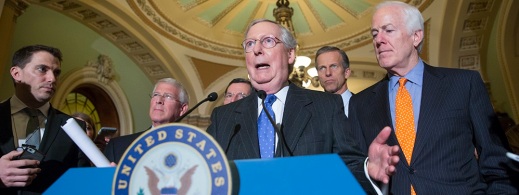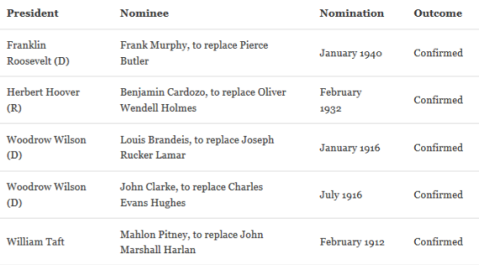How to Fill a Supreme Court Seat: A Guide for Senate Republicans

In early February Senator Mitch McConnell (R-KY) threatened to block President Obama’s Supreme Court nomination until after the new president took office saying,
The American people should have a voice in the selection of their next Supreme Court Justice. Therefore, this vacancy should not be filled until we have a new president.
Since, many republicans have joined McConnell’s “movement” even forming pro forma sessions with no particular agenda to specifically dodge a meeting with the president so that it impedes the progress on filling Scalia’s old seat (more on this process later).
Given this purposeful gridlock from the GOP, I thought it might be useful to put together a guide for senate republicans on the arguments against what they are doing and how to eventually fill the vacant Supreme Court seat, like the Constitution requires.

As we can see, most of the time throughout history nominees are accepted without a hitch. The two primary factors that disrupt a nominees success are their political ideology and qualifications. The run-of-the-mill strategy for presidents currently is to select a centrist candidate with unquestionable qualifications. Most of the cases in which we see a rejection of a candidate has been because of these two areas. Yet, even ultra liberals like Ruth Bader Ginsburg passed with a 96-3 vote and ultra conservatives like Scalia passed unanimously 98-0. So qualifications matter.
So who does Obama want to put up on the Supreme Court? Obama has selected Judge Merrick Garland who has a Harvard law degree, has worked in the Supreme Court before, aided in the prosecution of the Unabomber, and is the current incumbent Chief Judge of the United States Court of Appeals for the District of Columbia Circuit. Qualifications? Check. As for ideology, Garland has been considered by many to be a centrist/liberal candidate. Ideology? Check.
Yet, we know that is not about past nominees or about the candidates likelihood of passing in itself, for republicans it is largely about Obama putting someone up for nomination on an election year.
This specific point generated the following claim from Mike Honda (D-CA)
Six justices [on the U.S. Supreme Court have been] confirmed in presidential election years since 1912.
Politifact researched this and gave it a “True” rating, going even further to note that five of these election-year nominees were actually confirmed by the Senate – shown below.

I think a final point to be made is the irony of preaching the Constitution to Republicans. Republicans often tout their sincerity and divine love for the Founding Fathers and the Constitution yet appear to have an affair when it comes to Obama doing his Constitutional duty listed in Article II, section 2.2.
So overall, Obama is merely following the historical precedent of putting up a nominee that is moderate and well qualified, the Senate in the past has typically approved these candidates – even on election years multiple times. If Republicans truly want to tout the Constitution, then they should at least consider Obama’s nominee.
Moving forward, what does this process look like? The Washington Post put together a pretty accurate info-graphic that explains the process pretty well:

So Obama’s nomination (eventual nomination that is) would be followed by an initial filter, followed by some initial hearings from the Senators and President (but have been stifled by the make-believe meetings Senators have arranged for themselves). There would then be a committee vote; if passed, the President would leave the process up to the Senate, bringing it to a CSPAN broadcast live debate which often includes any filibusters any big objectors would want. Following the the filibuster process, a final vote would be held and the nomination is usually confirmed. Clockwork.
Except this nomination has been anything but clockwork. The Senate Majority Leader Mitch McConnell and his followers have held strong in not allowing the process to reach the first hearing or committee vote. The fear from republicans is not the “American people” and their “voice” on this matter (the American people voiced their opinion when they voted for Obama), but rather the political make up of the Supreme Court moving liberal. When ultra-conservative Scalia passed away a would-be conservative vacancy opened up – filling his spot with a liberal candidate would favor the court in a liberal manner for the lifelong term Supreme Court Justices serve.
There certainly is a lot on the line given this fact, the future of social issues in America, campaign financing, and even Senate/President duties are likely to be ruled on in a liberal manner if the Senate takes the nomination. Yet, they have no reason not to, History, the qualifications of the candidate, and even the Constitution demand they hear Obama’s nomination – we’re just waiting on the Republicans.
What only makes this better is that seven current Republican senators voted to confirm Garland to the federal bench way back in 1997: Daniel Coats (IN), Thad Cochran (MS), Susan Collins (ME), Orrin G. Hatch (UT), James M. Inhofe (OK), John McCain (AZ), and Pat Roberts (KS). For that vote Garland was confirmed 76-23 under Bill Clinton.
In addition to the Constitution, I have to cite one influential book that rather holistically covers the Supreme Court, it is Dr. Lawrence Baum’s “The Supreme Court” 11th edition by Sage Publications. The history, the process, and many of the arguments in this article were made well in advance by this paramount legal scholar. It can be found in many places, Chegg and Amazon being two.